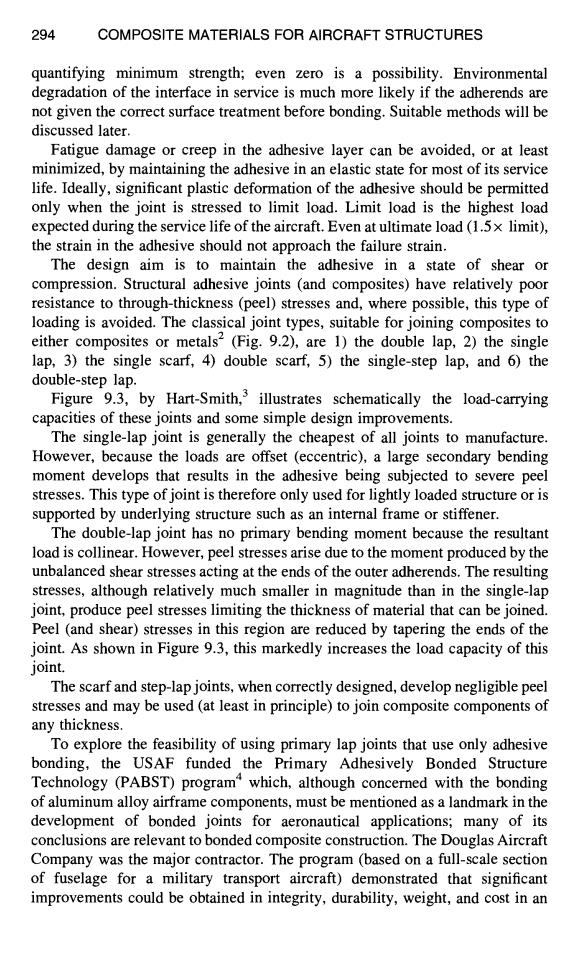正在加载图片...

294 COMPOSITE MATERIALS FOR AIRCRAFT STRUCTURES quantifying minimum strength;even zero is a possibility.Environmental degradation of the interface in service is much more likely if the adherends are not given the correct surface treatment before bonding.Suitable methods will be discussed later. Fatigue damage or creep in the adhesive layer can be avoided,or at least minimized,by maintaining the adhesive in an elastic state for most of its service life.Ideally,significant plastic deformation of the adhesive should be permitted only when the joint is stressed to limit load.Limit load is the highest load expected during the service life of the aircraft.Even at ultimate load(1.5x limit), the strain in the adhesive should not approach the failure strain. The design aim is to maintain the adhesive in a state of shear or compression.Structural adhesive joints (and composites)have relatively poor resistance to through-thickness(peel)stresses and,where possible,this type of loading is avoided.The classical joint types,suitable for joining composites to either composites or metals2(Fig.9.2),are 1)the double lap,2)the single lap,3)the single scarf,4)double scarf,5)the single-step lap,and 6)the double-step lap. Figure 9.3,by Hart-Smith,3 illustrates schematically the load-carrying capacities of these joints and some simple design improvements. The single-lap joint is generally the cheapest of all joints to manufacture. However,because the loads are offset (eccentric),a large secondary bending moment develops that results in the adhesive being subjected to severe peel stresses.This type of joint is therefore only used for lightly loaded structure or is supported by underlying structure such as an internal frame or stiffener. The double-lap joint has no primary bending moment because the resultant load is collinear.However,peel stresses arise due to the moment produced by the unbalanced shear stresses acting at the ends of the outer adherends.The resulting stresses,although relatively much smaller in magnitude than in the single-lap joint,produce peel stresses limiting the thickness of material that can be joined. Peel(and shear)stresses in this region are reduced by tapering the ends of the joint.As shown in Figure 9.3,this markedly increases the load capacity of this joint. The scarf and step-lap joints,when correctly designed,develop negligible peel stresses and may be used (at least in principle)to join composite components of any thickness. To explore the feasibility of using primary lap joints that use only adhesive bonding,the USAF funded the Primary Adhesively Bonded Structure Technology (PABST)program which,although concerned with the bonding of aluminum alloy airframe components,must be mentioned as a landmark in the development of bonded joints for aeronautical applications;many of its conclusions are relevant to bonded composite construction.The Douglas Aircraft Company was the major contractor.The program (based on a full-scale section of fuselage for a military transport aircraft)demonstrated that significant improvements could be obtained in integrity,durability,weight,and cost in an294 COMPOSITE MATERIALS FOR AIRCRAFT STRUCTURES quantifying minimum strength; even zero is a possibility. Environmental degradation of the interface in service is much more likely if the adherends are not given the correct surface treatment before bonding. Suitable methods will be discussed later. Fatigue damage or creep in the adhesive layer can be avoided, or at least minimized, by maintaining the adhesive in an elastic state for most of its service life. Ideally, significant plastic deformation of the adhesive should be permitted only when the joint is stressed to limit load. Limit load is the highest load expected during the service life of the aircraft. Even at ultimate load (1.5x limit), the strain in the adhesive should not approach the failure strain. The design aim is to maintain the adhesive in a state of shear or compression. Structural adhesive joints (and composites) have relatively poor resistance to through-thickness (peel) stresses and, where possible, this type of loading is avoided. The classical joint types, suitable for joining composites to either composites or metals 2 (Fig. 9.2), are 1) the double lap, 2) the single lap, 3) the single scarf, 4) double scarf, 5) the single-step lap, and 6) the double-step lap. Figure 9.3, by Hart-Smith, 3 illustrates schematically the load-carrying capacities of these joints and some simple design improvements. The single-lap joint is generally the cheapest of all joints to manufacture. However, because the loads are offset (eccentric), a large secondary bending moment develops that results in the adhesive being subjected to severe peel stresses. This type of joint is therefore only used for lightly loaded structure or is supported by underlying structure such as an internal frame or stiffener. The double-lap joint has no primary bending moment because the resultant load is collinear. However, peel stresses arise due to the moment produced by the unbalanced shear stresses acting at the ends of the outer adherends. The resulting stresses, although relatively much smaller in magnitude than in the single-lap joint, produce peel stresses limiting the thickness of material that can be joined. Peel (and shear) stresses in this region are reduced by tapering the ends of the joint. As shown in Figure 9.3, this markedly increases the load capacity of this joint. The scarf and step-lap joints, when correctly designed, develop negligible peel stresses and may be used (at least in principle) to join composite components of any thickness. To explore the feasibility of using primary lap joints that use only adhesive bonding, the USAF funded the Primary Adhesively Bonded Structure Technology (PABST) program 4 which, although concerned with the bonding of aluminum alloy airframe components, must be mentioned as a landmark in the development of bonded joints for aeronautical applications; many of its conclusions are relevant to bonded composite construction. The Douglas Aircraft Company was the major contractor. The program (based on a full-scale section of fuselage for a military transport aircraft) demonstrated that significant improvements could be obtained in integrity, durability, weight, and cost in an